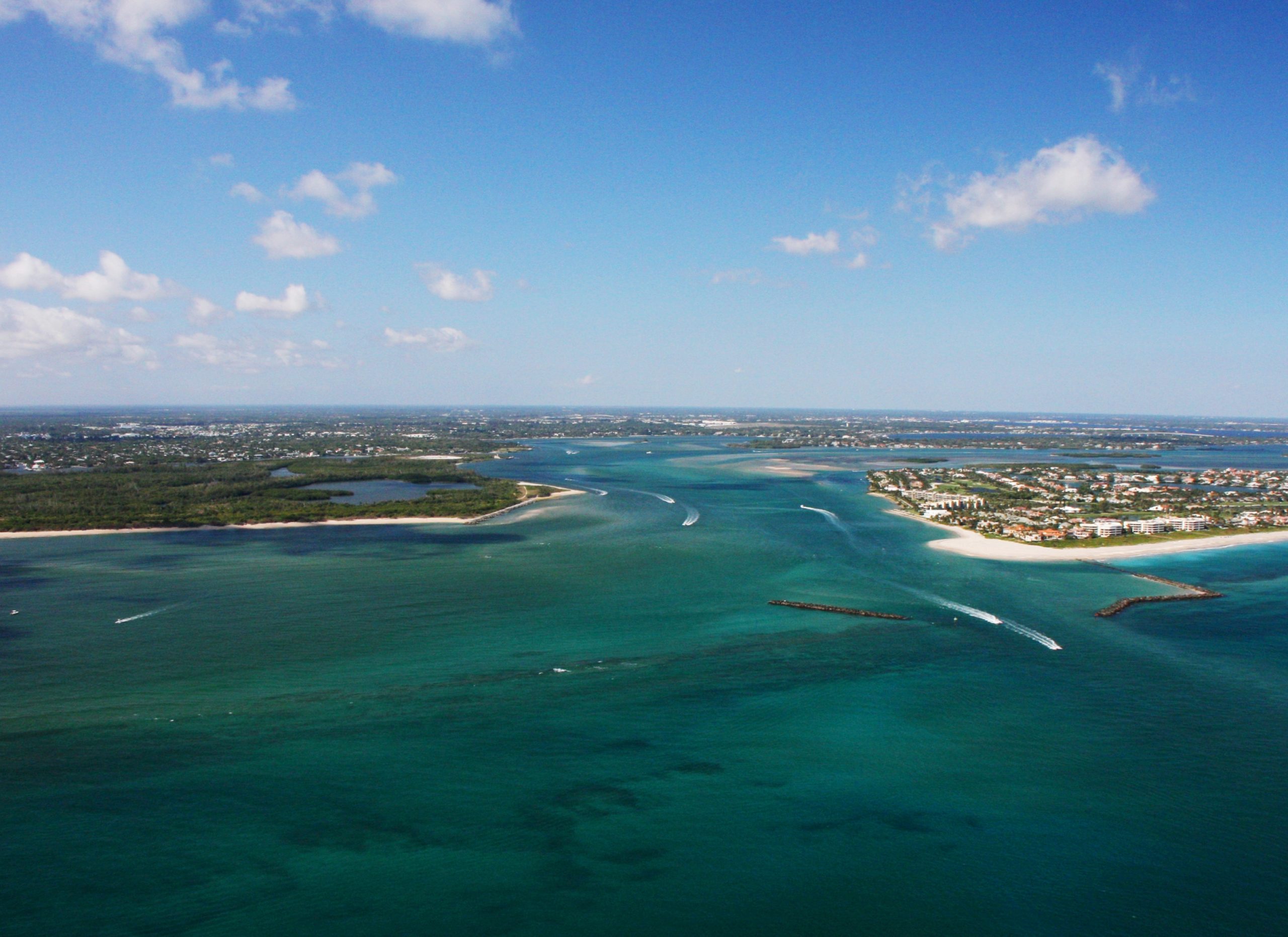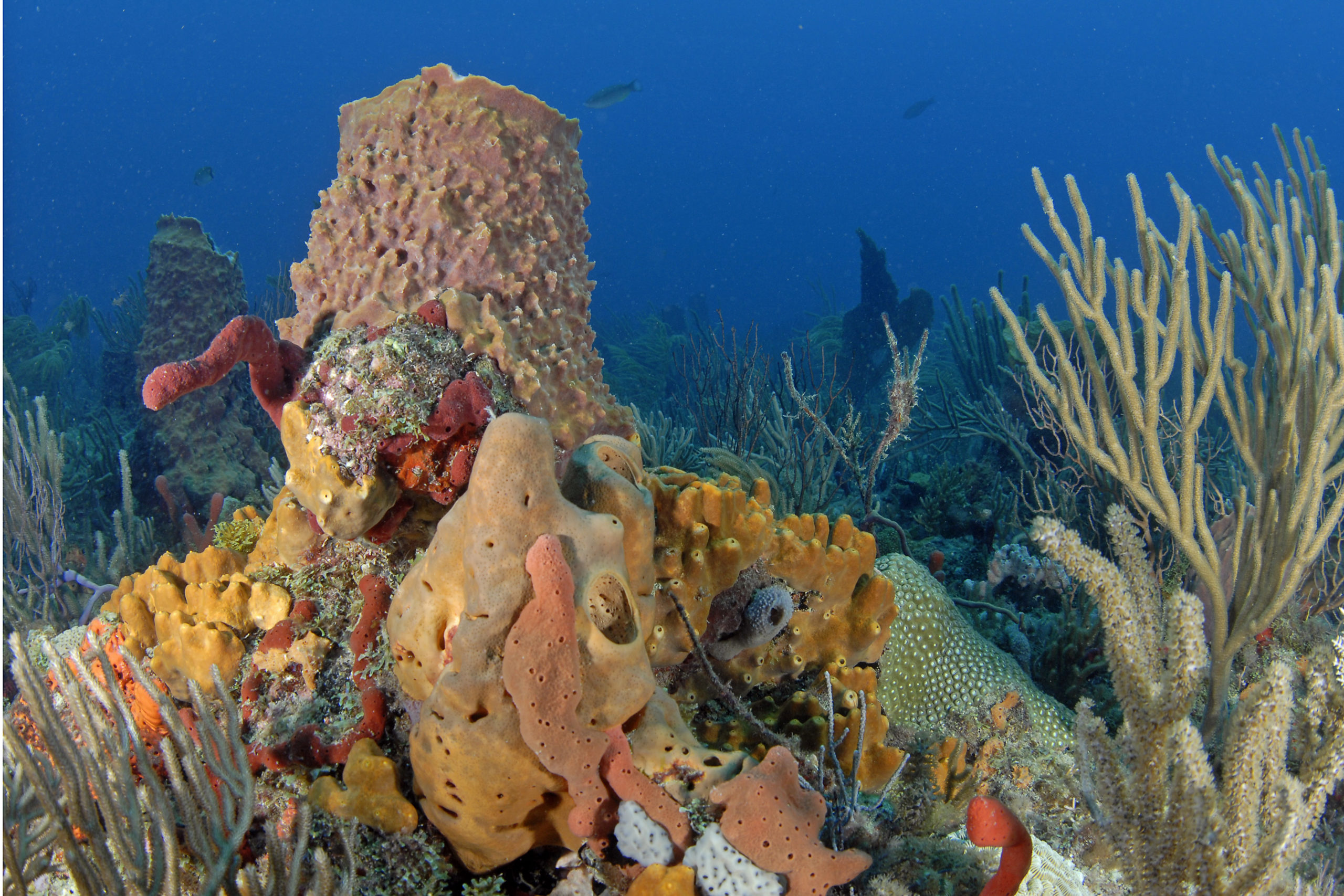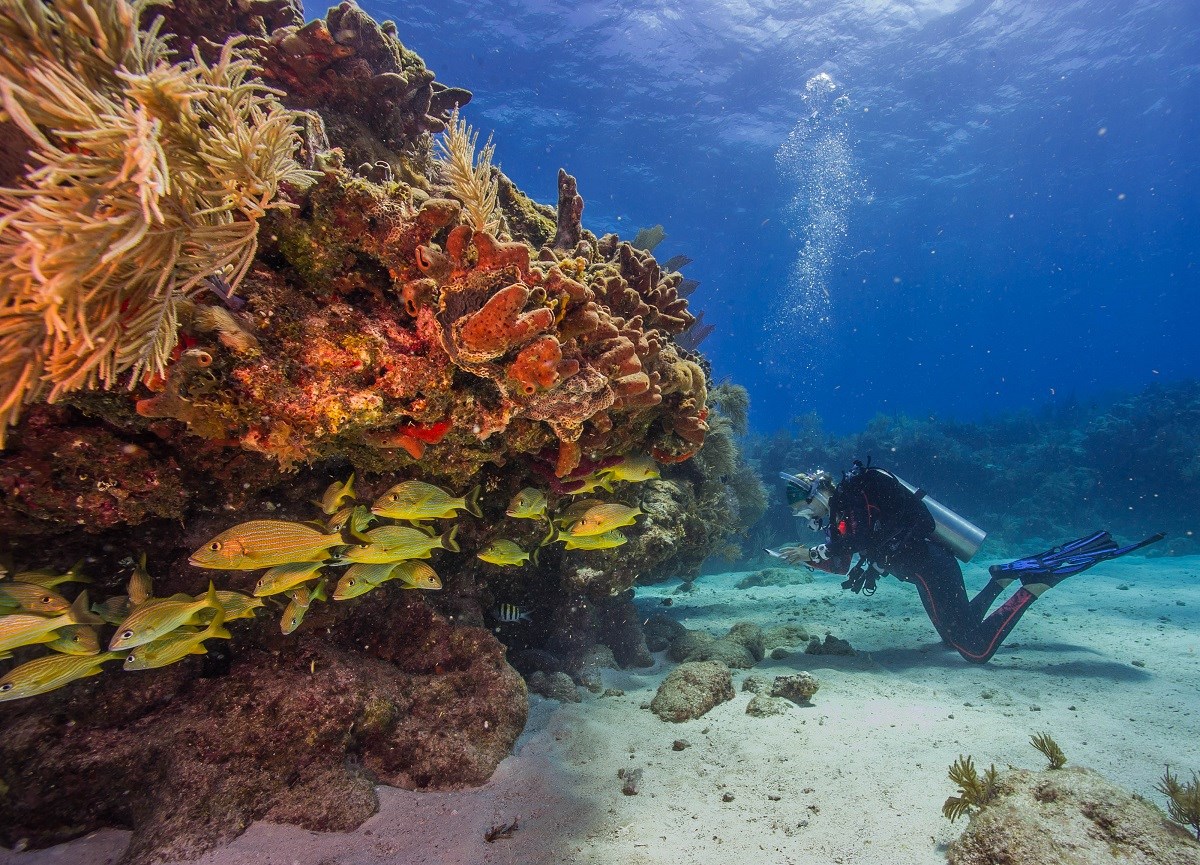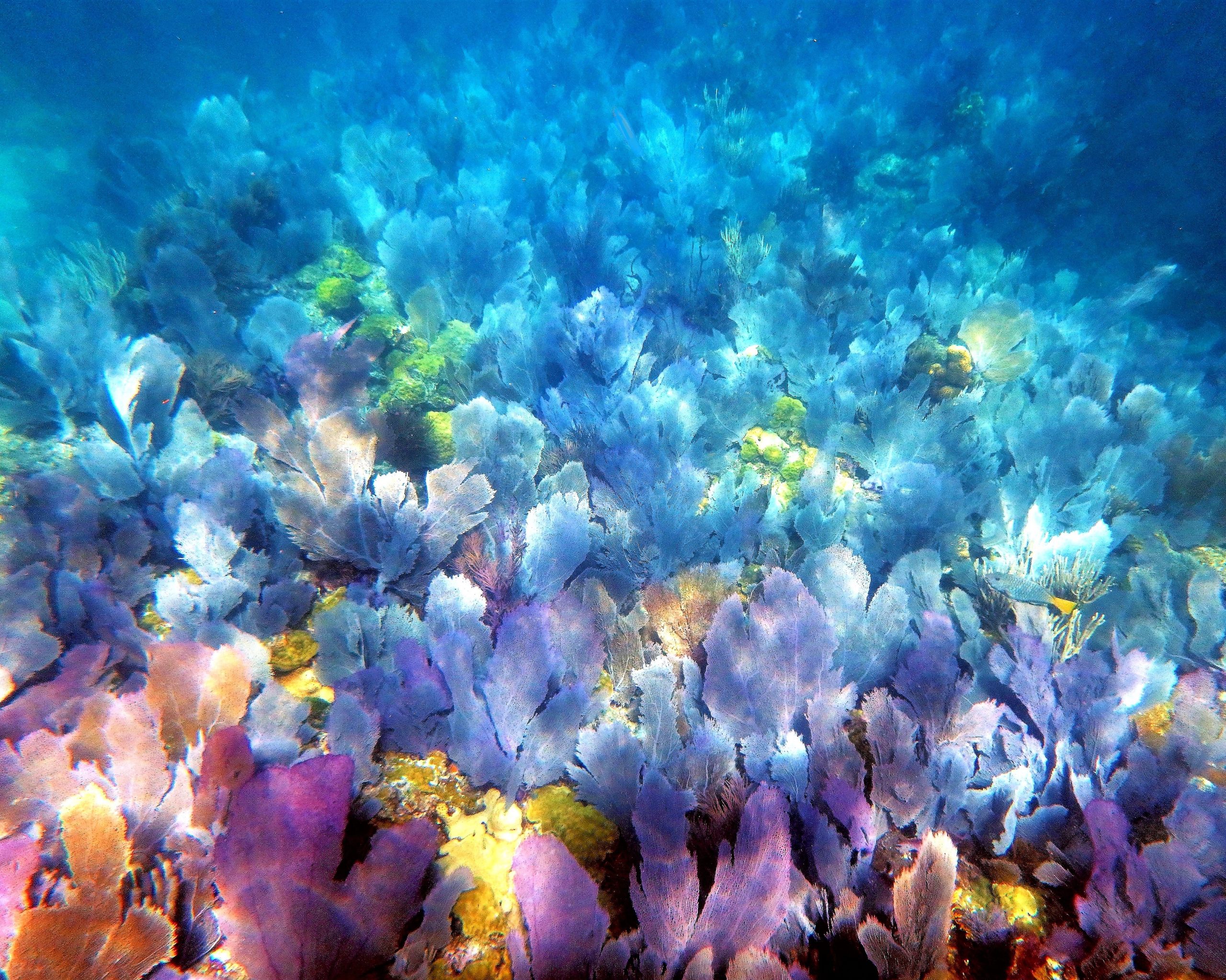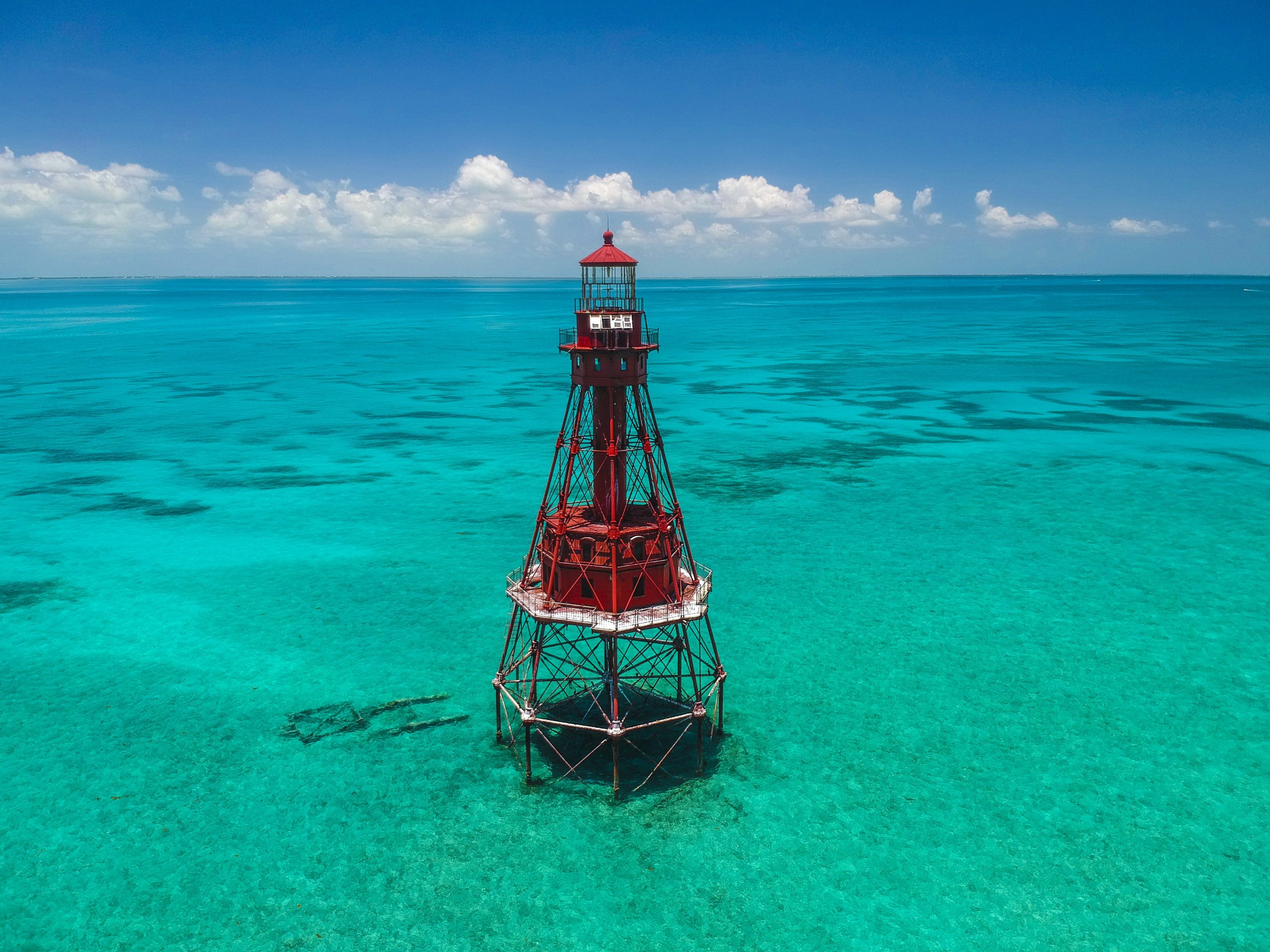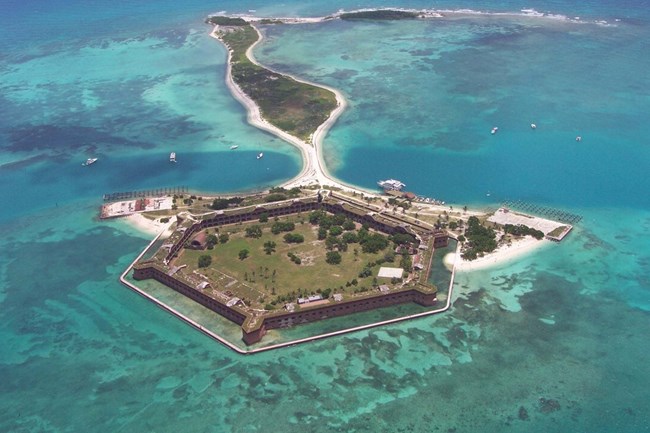Facts and History
Florida is the only state in the continental U.S. to have extensive, shallow coral reef formation near its coast. The reef extends over 350 miles from the Dry Tortugas in the Gulf of America to the St. Lucie Inlet in Martin County. Formations in Florida’s Coral Reef are very similar to those found in the Bahamas and Caribbean Sea.

The reef begins in the Dry Tortugas National Park, about 70 miles west of Key West, Florida. This 100-square-mile park, 99% of which is water, is home to an abundance of marine life. There are also seven small islands, critical to migratory birds along their journeys.
North of the Dry Tortugas, two-thirds of the reef lie within the boundaries of the Florida Keys National Marine Sanctuary (FKNMS). Designated on Nov. 16, 1990, FKNMS is one of 15 marine protected areas that make up the National Marine Sanctuary System.
Administered by the National Oceanic and Atmospheric Administration (NOAA) and jointly managed with the state of Florida, FKNMS protects 3,800 square miles of waters surrounding the Florida Keys, with the shoreward boundary of the sanctuary defined as the mean high-water mark, essentially meaning that once you set foot in Keys waters, you have entered the sanctuary. Within the boundaries of the sanctuary lie spectacular, unique and nationally significant marine resources, including the barrier reef, patch reefs, in-shore fringing reefs, extensive seagrass beds, mangrove-fringed islands and more than 6,000 species of marine life.
The sanctuary also protects artifacts of our nation’s history such as shipwrecks and other archaeological treasures. Additionally, within FKNMS there are four national wildlife refuges, administered by the U.S. Fish and Wildlife Service, including the Key West National Wildlife Refuge. It protects the area west of Key West including the Marquesas Islands and the reefs in that area.
Coupon Bight Aquatic Preserve is the state of Florida’s southernmost aquatic preserve and the only one to include one of the iconic reefs along Florida’s Coral Reef, Newfound Harbor Patch Reef (also known as Munson Rocks). Located off Big Pine Key in the Lower Keys, Newfound Harbor Patch Reef includes a FKNMS-designated sanctuary preservation area protecting a large, biodiverse patch reef as well as several smaller patch reefs that are open to fishing.
Renowned for being the country’s first undersea park, John Pennekamp Coral Reef State Park encompasses an impressive 70 nautical square miles off Key Largo in FKNMS. The park is approximately 25 miles in length and extends 3 miles into the Atlantic Ocean. This includes numerous patch reefs with high coral cover and biodiversity. The state park maintains mooring buoys at the more popular sites, including Turtle Rocks, Basin Hill, Higdon’s Reef, Cannon Patch, Mosquito Bank and Three Sisters North.
The park was added to the National Register of Historic Places on April 14, 1972.
Starting at the northern boundary of FKNMS and Pennekamp, the reef extends through Biscayne National Park, a 270-square-mile park that protects Biscayne Bay. This national park encompasses four distinct ecosystems: shoreline mangrove swamps, islands made of coral limestone, shallow seagrass habitats of the bay, and the coral reef.
The northernmost section of Florida’s Coral Reef lies in the Kristin Jacobs Coral Reef Ecosystem Conservation Area.
The Kristin Jacobs Coral Reef Ecosystem Conservation Area, formerly referred to as the Southeast Florida Coral Reef Initiative region, was officially established on July 1, 2018. This conservation area, also referred to as the Coral ECA, includes the sovereign submerged lands and state waters offshore of Martin, Palm Beach, Broward and Miami-Dade counties from the northern boundary of Biscayne National Park to the St. Lucie Inlet.
In 2021, it was renamed in honor of the late coral champion state Representative Kristin Jacobs.
Prior to the designation of the Coral ECA, the northern portion of the reef lacked a reef-specific, state-adopted management plan for its sustainability and conservation. This section of the reef is affected by extremely high year-round usage, water quality degradation and other threats that initiated the five focus areas of the DEP Coral Reef Conservation Program and Southeast Florida Coral Reef Initiative.
What is coral?
Although corals may look like rocks or plants, they are in fact animals, closely related to jellyfish and anemones. Corals are sessile, meaning they attach themselves to the ocean floor. They are classified under the phylum Cnidaria and the class Anthozoa.
A single coral is a colonial organism, meaning it is made up of hundreds to thousands of individual animals called polyps. Corals are often referred to as colonies. Each soft-bodied polyp has a stomach with only one opening that is surrounded by tentacles. A polyp both takes in food and expels waste through its opening. The tentacles are used in defense, to pull food into the mouth and to clear away debris.
All polyps on one coral colony are connected to one another by a thin band of living tissue, called the coenosarc.
Where are corals found?
Coral communities can be found in shallow or deep waters. However, coral reef development occurs only in areas with specific environmental characteristics: a solid structure for attachment; tropical or subtropical temperatures; clear waters low in phosphate and nitrogen nutrients; and moderate wave action to disperse waste and bring oxygen and plankton to the reef.
Other factors that influence where corals can live include the salinity of the water (the amount of salt), the amount of sunlight that penetrates the water, and the presence of species that help control macroalgae, like urchins and herbivorous fish.
Florida’s offshore waters have these characteristics and support shallow water reefs.
How do corals eat?
Corals get their nutrients from multiple sources. They feed on tiny particles in the water column by extending their tentacles, which are armed with stinging cells called nematocysts, into the surrounding water to catch prey, and they obtain nutrients from microscopic algae, colloquially called zooxanthellae, that live inside their tissues in a unique partnership called symbiosis.
Symbiosis means that each partner benefits from the partnership. Corals obtain energy, nutrients and oxygen from these algae, and the symbionts receive nutrients and protection. The symbionts also give the corals their beautiful spectrum of colors.
What is coral bleaching?
Bleaching is a stress response that results when the coral-algae symbiosis breaks down. The corals lose their algae, causing them to turn pale or completely white, which is referred to as bleaching.

Attribution: Mote Marine Lab
Coral bleaching can be caused by a wide range of environmental stressors such as pollution, oil spills, increased sedimentation, extreme increases or decreases in ocean temperatures, fluctuations in salinity, low oxygen, disease and predation.
Bleached corals are still living, and if the environmental conditions return to normal soon enough, the corals can regain or regrow their symbionts and survive the bleaching event. If the stressors are severe, repeated or prolonged, however, bleaching can lead to the death of corals. Bleached corals are more susceptible to disease, predation and death because they are without their primary energy source.
Localized or colony-specific bleaching events have been recorded for over 100 years. Localized bleaching is often caused by direct human-caused stressors, such as spikes in pollution or freshwater runoff, which can be addressed by land-based management that reduces those stressors. However, since the 1980s, scientists have seen mass bleaching events in which a wide range of coral species bleach over a large area of a reef.
Along Florida’s Coral Reef, there is an indication that these mass coral bleaching events have increased in frequency and severity since the 1980s. While the influence of local stressors can explain small-scale bleaching events, the widespread mass bleaching events are mostly attributed to climate change.

in Rock Key.
Attribution: Emily Hower
Because most corals live close to their upper temperature limits, a temperature increase of only 2° Celsius (4° Fahrenheit) above the long-term average can trigger mass bleaching, particularly when prolonged. This was demonstrated in 1997-1998, when anomalously high ocean temperatures worldwide – linked to the El Nino climate phenomenon – coincided with bleached reefs in over 50 countries.
In situations where bleaching causes extensive coral death, recovery is dependent on new coral recruits settling and growing on the reef. This is a time-consuming process, even on relatively healthy reefs. Unassisted regrowth of reefs that have been severely impacted by bleaching may take decades or centuries, and the new reef may be significantly different from that which existed before bleaching.
In locations suffering from pollution, decreased herbivore biomass, repeated stressors or other chronic pressures, reef recovery can be particularly slow or inhibited altogether.
How are reefs formed?
Reef growth is extremely slow; an individual coral colony may grow only a half-inch to 7 inches (1-18 cm) a year, depending on the species. Stony corals are the major reef architects. Individual polyps in stony coral colonies extract calcium from seawater and combine it with carbon dioxide to construct the elaborate calcium carbonate (limestone) skeletons that form a reef’s backbone.

Attribution: Shaun Wolfe, National Park Service
By repeating this process over many years, stony corals can create massive reef structures that provide habitat for many important species, including most of Florida’s sport fish species, particularly during their younger development stages.
How do corals reproduce?
Attribution: Mote Marine Laboratory. (Coral Reef Restoration | Research Programs | Mote Marine Laboratory & Aquarium)
Corals can reproduce asexually through budding or fragmentation and sexually via broadcast spawning or brooding.
Budding occurs when new polyps form from a dividing parent polyp, causing a coral colony to grow outward. This process produces polyps that are genetically identical to the parent polyp.
Fragmentation occurs when a portion of a larger colony is broken off from the main colony, creating a new colony that is genetically identical to the original colony. This can result from storm activity and disturbances from large marine animals like turtles. The new fragment will settle and grow, however, only if it is exposed to favorable growth conditions.
Broadcast spawning occurs as a synchronized event, when corals release large quantities of eggs and sperm at about the same time in response to cues from the environment that include temperature and lunar cues. Because corals are sessile and cannot move, timing is very important. The egg and sperm join to form free-floating larvae called planulae that are transported by water currents until they land on suitable substrate to settle and grow.
This type of sexual reproduction contributes to offspring that are spread over a wide geographical area.
What types of reefs are found in Florida?
The three major types of coral reefs around the world:
- Atolls.
- Fringing reefs.
- Barrier reefs.
Fringing reefs form borders along shorelines and grow toward the sea from the shore. Barrier reefs form parallel to shore but are separated from it by a lagoon.
Atolls are reefs that continue to grow upward after the island they surround has sunk. Other types of reefs are bank reefs, which have no obvious link to a coastline, and patch reefs, which are small, isolated reefs that grow between the reef tract and land.
Florida’s Coral Reef is composed of many different types of reefs and most closely resembles a barrier reef; however, the reefs are closer to shore, and they lack the shallow inshore lagoons found on most barrier reefs. For this reason, Florida’s Coral Reef is more aptly referred to as a bank-barrier reef. Florida also has patch reefs, which grow in shallower water in between the reef and land. Patch reefs are typically small (the size of a backyard or a small home).
Additionally, there is one atoll on Florida’s Coral Reef, the Marquesas Islands, that was initially formed as the result of a prehistoric meteor strike.

Attribution: Dawn Witherington
Generally, the reefs in the Coral ECA occur in three parallel lines extending north from Miami-Dade County and changing to more isolated patch reefs in Martin County.
Different reef organisms characterize the type of habitats found along Southeast Florida’s reefs, typically transitioning from a cover of algae and small octocorals nearshore to numerous octocorals and varied stony coral populations on the outer reefs.
In the Florida Keys, the reef can be found several miles offshore. These reefs tend to be a spur and groove structure, or a series of successive ridges separated by channels. Additionally, small patch reefs can be found in between the islands and the outer reef. Farthest south, the coral reefs in the Dry Tortugas are found in the shallow waters surrounding the seven islands of the national park.
The coral reefs live on platforms created by calcified corals that have accumulated over thousands of years up to 15 meters above the seafloor. In the wide channels between these platforms are soft corals and sponges.
The various reef architectural and compositional components create an environment that is ecologically diverse and productive, and one that supports all the plants and animals that inhabit Florida’s Coral Reef.
What types of corals can be found in Florida?
Corals take on many shapes and are generally classified in two main classes: hexacorals and octocorals.
Hexacorals have polyps with six tentacles (or six-fold symmetry), and octocorals have polyps with eight feather-like tentacles (or eight-fold symmetry). Hexacorals include stony corals, also known as scleractinian corals, and corallimorphs, which look similar to stony corals but lack a stony skeleton. Octocorals include sea fans, gorgonians and sea whips.
More than 45 species of stony corals and 35 species of octocorals are found along Florida’s Coral Reef. Marine sponges are also very important within the coral reef community, and more than 70 species can be found along Florida’s Coral Reef.
Historically, Florida’s reef-building corals were brain, star and branching, all of which are not as common now as they once were.
- Brain coral is dome-shaped and has the waves, folds and ridges that resemble those of a human brain.
- Star coral is also dome-shaped with a distinctive star pattern on its surface that is caused by the accordion-like folds within its polyp cups.
- Branching corals are so named because of their branchlike projections, resembling animal antlers.



What is the current state of our estuarine, coastal and ocean habitats?
Located within a mile of a densely populated, urban shoreline, Southeast Florida’s estuarine, coastal and ocean habitats face an ever-increasing list of threats. For example, recreational and commercial activities taking place on, in and above the water, as well land-based activities such as coastal development and pollution, are negatively affecting the coral reef ecosystem.
In 1950, it was estimated that Florida had over 5 million acres of seagrass. Currently, seagrasses cover nearly 2.5 million acres of shallow waters near Florida’s coastlines, estuaries and bays. Southeast Florida’s estuaries have recently had multiple seagrass die offs, primarily due to declining water quality by human-induced eutrophication. Mangrove communities in South Florida have steadily disappeared since the early 1900s as a result of coastal development and wetland infilling. Florida’s estimated 469,000 acres of mangrove forests contribute to the overall health of the state’s southern coastal zone.
Over time, the loss of nearshore hardbottom habitats may lead to a reduction in the populations of marine invertebrates, such as sponges, coral, lobster and crabs, and may cause significant changes to the food web close to shore. In the interconnected ocean and coastal environment, damage and habitat loss result in fewer natural resources for providing food, income and recreation.
